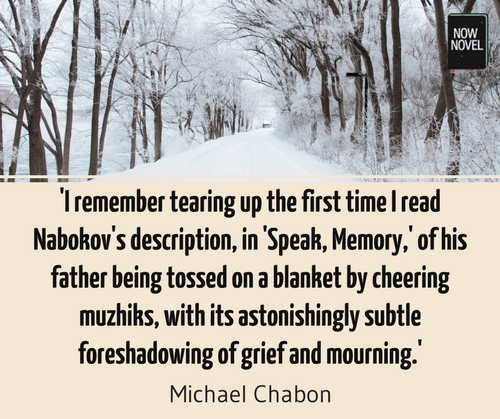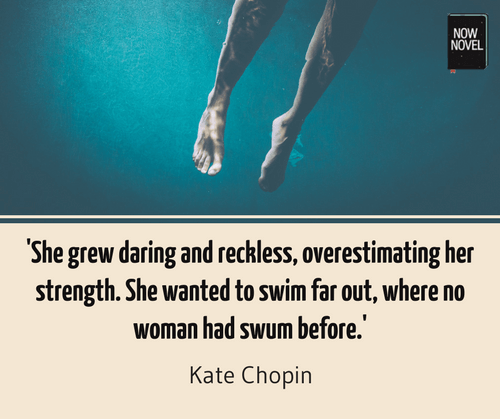Foreshadowing – a ‘warning or indication of a future event’ – is a useful device in storytelling. Hinting at what will happen serves multiple purposes (such as building tension and suspense). Read foreshadowing examples showing how to tease approaching plot developments:
First, a definition: What is foreshadowing?
As stated above, foreshadowing is a warning or indication of a future event. Synonyms for the verb ‘to foreshadow’ include ‘to prefigure’ or ‘to predict’ (although the latter carries more of a sense of guesswork/fortune-telling).
Let’s take an example of foreshadowing from the sci-fi TV series Black Mirror. In the episode “San Junipero”, a character in a virtual reality world meets a boy in a video arcade near the start of the episode who invites her to play a game. The game’s video intro on the screen behind him shows a car crashing into a wall on a loop.
Later in the episode, we find out that a car crash is a pivotal plot point explaining the girl’s backstory. The brief focus on the arcade machine loop early on in the episode helps to create suspense and foreboding. It’s an ominous foreshadowing of a key, emotional plot point.
Foreshadowing, of course, does not have to be negative or ominous. You could also foreshadow happy events. For example, a character who feels lonely when she passes two newlyweds emerging from the town church might later exit that same church, arm in arm with her groom.
This is an example of foreshadowing, too.
Another example of foreshadowing is found in our post on reading like a writer.
So what are ways to use foreshadowing in a story or novel?
1. Have your narrator tell readers partial facts about coming events
One of the most common foreshadowing examples is the narrator who ‘spills the beans’ (but not all of them) early on. Often, this is a narrator who looks back on events, before letting us relive, through their narration, what happened.
Two foreshadowing examples of this type:
In Donna Tartt’s The Secret History, narrator Richard shares partial information about a murder in the opening paragraphs. Richard tells us:
‘The snow in the mountains was melting and Bunny had been dead for several weeks before we came to understand the gravity of our situation. He’d been dead for ten days before they found him, you know.’
Even though the events he describes are in his past, to us they’re foreshadowing as we have not yet read an explanation for these events.
This type of foreshadowing charges scenes with suspense, although there are subtler types of foreshadowing. When we first meet Edward ‘Bunny’ Corcoran, alive and obnoxious, we wonder when the murder is going to occur.
Another foreshadowing example of this type, from Jeffrey Eugenides’ The Virgin Suicides:
‘On the morning the last Lisbon daughter took her turn at suicide – it was Mary this time, and sleeping pills, like Therese, the two paramedics arrived at the house knowing exactly where the knife drawer was, and the gas oven, and the beam in the basement from which it was possible to tie a rope.’
Here the narrator recalls tragic events at the Lisbon household, but, like Tartt, Eugenides delays revealing causes. We continue to uncover the situation that led to these acts.
Both authors withhold key facts. We might ask ‘Who murders Bunny? Who is Tartt’s nameless ‘we’ (the narrator plus who)?’
Great foreshadowing thus makes readers ask pressing questions about the unfolding story. This question-raising is key to writing a page-turner.
2. Show settings that foreshadow or symbolize key events
There are many foreshadowing examples – particularly in visual media such as film and TV – where writers foreshadow plot points using setting description.
For example, in a story about four friends’ coming of age, the opening frame might show a dilapidated tree-house falling apart. Later in the story, we see the friends building said tree-house and what it looked like in its glory days.
Why would you use foreshadowing this way to prefigure key events?
- To build tone and mood: Describing a tree-house that’s falling apart before showing its building could create a nostalgic, elegiac mood. Over the course of the story the reader or viewer has a sense of how things change (and sometimes fall apart and crumble) over time.
- To create motifs or symbolism:Motifs and symbols are ideas and imagery that recur throughout a story and build the emotional effect. For example, the treehouse could be a symbol suggesting the intimacy of friendship (it’s tucked away in a tree) and the innocence of childhood. The first scene could also subtly suggest that something will happen between the main characters to test (or even sunder) their bond.

3. Use dialogue that hints at future revelations
There are also many foreshadowing examples that use dialogue to build suspense and anticipation.
For example, Stephen King begins his classic paranormal horror novel The Shining with an interview foreshadowing future developments:
“I asked if your wife fully understood what you would be taking on here. And there’s your son, of course.” He glanced down at the application in front of him. “Daniel. Your wife isn’t a bit intimidated by the idea?”
“Wendy is an extraordinary woman.”
“And your son is also extraordinary?”
Jack smiled, a big wide PR smile. “We like to think so, I suppose. He’s quite self-reliant for a five-year-old.”
Jack Torrance, King’s central character, is interviewing for a post as winter caretaker at the Overlook Hotel in the Colorado Rockies. The interviewer’s questions about Torrance’s wife being ‘intimidated’ and his focus on whether they can cope or not foreshadows the menacing, violent events that unfold.
The questions about Danny being ‘extraordinary’ and ‘self-reliant’ also foreshadow how Danny manages to resist the supernatural forces of the hotel. King shows this self-reliance in Danny helping his mother escape the hotel in the course of the story .
As the example above shows, you can use foreshadowing dialogue to hint:
- Character traits: King indicates important traits in Danny that will help him survive the resort from the start
- Plot complications and obstacles: The interviewer’s concern gives us an inkling that managing the Overlook is tougher than we or Jack Torrance might think
Think of ways you can also use dialogue to foreshadow character strengths (or weaknesses) and key events, as well as impending tone and mood.
4. Show physical signs before their results
We mentioned showing objects or settings as symbols foreshadowing events in the example of a childhood tree-house above. You can also use objects and physical signs in a more literal way.
For example, in a tragedy about a baker who forgets to turn off the gas and blows up their shop, you could foreshadow this event by showing:
- Objects revealing the baker’s distracted or forgetful state (e.g. shop signs written wrong)
- Physical events that would typically precede the main disaster (e.g. a recurring smell of cooking gas or a faint hissing sound)
As an example, you might write the following:
‘The lady at the counter wrinkled her nose, glancing past him, to the stove-top he’d been wiping down when the bakery doorbell rang.’
Physical signs and indications are useful tools for foreshadowing because they can be as subtle – a customer’s reaction to a smell – or as blatant as you like.
When using physical signs to foreshadow, the rules of ‘Chekhov’s Gun’ apply. If you show a gun in the first scene of your story and give it emphasis, it needs to go off or be significant in other ways later in your story.
5. Show future scenes in miniature
You might foreshadow individual plot points, but you can also foreshadow entire scenes.
For example, if there’s a punch-up in a school corridor at some point in your story, and your main character intervenes and is injured, you could precursor this scene with a minor scuffle earlier in the narrative.
Repeat scenes and character experiences often serve dual purposes. They hint at future events, and also give the means to develop character.
For example, if your main character, a caring student, can’t decide whether to intervene or not in the first scuffle, this could set up the emotional conditions (for example, his regret at not stepping in) propelling his later intervention.
Repetition plus change is the bedrock of storytelling. So think about ways you can employ foreshadowing in your story to show characters changing and growing.

6. Name (but don’t explain)
This is a type of foreshadowing using narrative exposition. It entails name-checking an impending event or occasion without giving the reader any further information.
This is a useful way to be cryptic and teasing and build anticipation.
An example of foreshadowing using this method:
‘The Gathering always happened on the last new moon of the year. Everyone had grown restless as the equinox came and went.’
The key with this type of foreshadowing is to balance it with non-cryptic, clear narration in the present time of your story. If every other line is littered with mysterious allusions to events, the effect will likely tire readers.
Is there an example of foreshadowing you’ve read that you find particularly strong? Share it in the comments below.
Remember that foreshadowing is just one of many examples of literary devices, have a look at this list to see what other devices you could use.
Get help creating your plot synopsis, writing better dialogue and more – take an online writing course (starting anytime) and get detailed, actionable feedback.


2 replies on “Foreshadowing examples: How to tease plot developments”
These are tough skills to develop–without crabbing the gag–but well worth it. Thanks for the tips.
Thanks, Elias! I appreciate your taking the time to leave feedback. Thanks for reading.